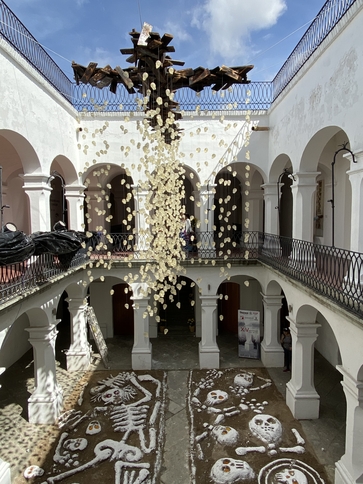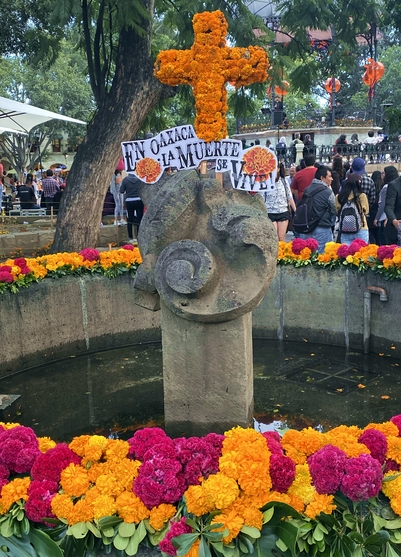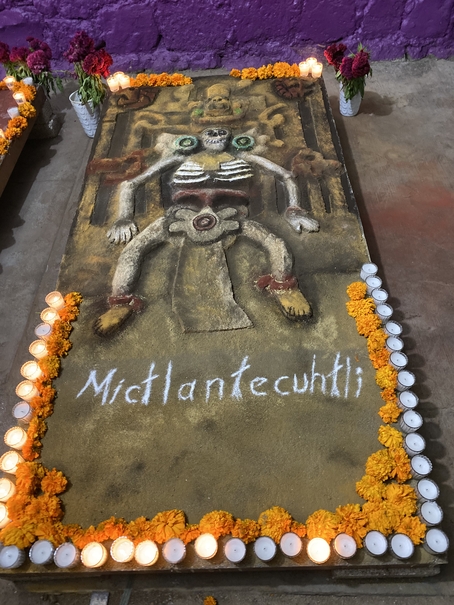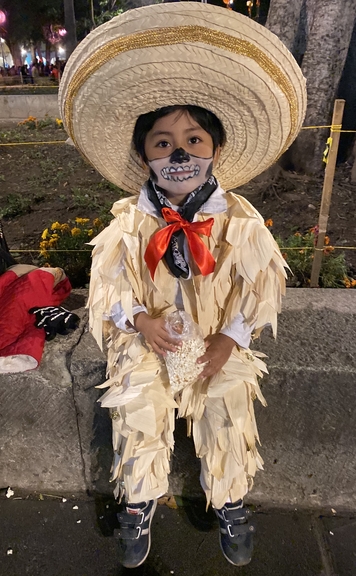
| Return to Día de Muertos. |

These pictures were taken in 2019 in Oaxaca as Mexico was observing the Day of the Dead (called Día de Muertos in Mexican Spanish and Día de los Muertos north of the border).
Background Review. The Day of the Dead is “All Souls Day” (November 2nd), when the church says you should pray for the dead “being purified in the sufferings of purgatory.” It follows “All Saints Day,” November 1st, when one prays to and about anybody ever sainted. (This is what Halloween is the “‘een” of, when all sorts of creatures get loose to give the saints somebody to chase away on November first.)
(Note to potential purists: If All Souls occurs on a Sunday, it can be moved to Monday. Like Veterans’ Day.)

In Mexico, All Souls is the day when the family dead come home to visit. (Not all of them. If they have died within a year, they have to stay in purgatory till they have done their year.) Altars are erected to hold pictures of the departed and food for their delectation; bread is baked into images of the departed (or sometimes other people). Graves are cleaned up (which they usually badly need). And everything is decorated with yellow and orange flowers, especially marigolds, often punctuated with rose-colored cockscombs, which bloom about the same time.
Nowadays globalization has led to a seeping of Halloween into the festival, with costumes and occasional trick-or-treating for candy. (It turns out that Americans are especially keen on sugar skulls, while Mexicans think pointed witch hats are pretty cool.) In 2019 influence from the brilliant Pixar filmCoco (Trailer 1, Trailer 2) was much in evidence.

Local celebrations vary in trivial ways. For a description of the observation in the proudly Nahuatl-speaking town of Mixquic, about an hour from Mexico City, click here. In Mixquic the souls of dead children arrive at noon on Halloween. The adult souls follow at noon on All Saints. Everybody hangs out in the cemetery on All Souls, and on November 3rd people visit back and forth, give each other gifts, and eat whatever is left on anybody’s altars. People in Mixquic think that (1) that is how everybody does it, and (2) they are the only people who do it that way. In the state of Aguascalientes, on the other hand, there is a publicly funded parade, complete with plump politicans on a reviewing stand waving to animated skeletons on large floats.
The minor Aztecness of the whole event tends to be romanticized; The skull-rack of papier-maché skulls on the linked Día de Muertos page was an example from Tijuana. Outside Oaxaca cemeteries in 2019, among “sand paintings” of Jesus, Mary, and various saints, there were a few representations of Mictlanteuctli, the prehistoric lord of Mictlan, the land of the dead (whence the archaeological site of Mitla gets its name). (Click here for an Aztec account of his realm.)
Since not every place does quite the same thing (which allows Mixquic to claim uniqueness), here is what is customary in Oaxaca:

Because the Oaxaca celebration is especially picturesque, lots of pictures have here been arrayed on separate pages, without (much) text, linked as follows:
Background Design: Artisanal Paper, Francisco Toledo, Oaxaca